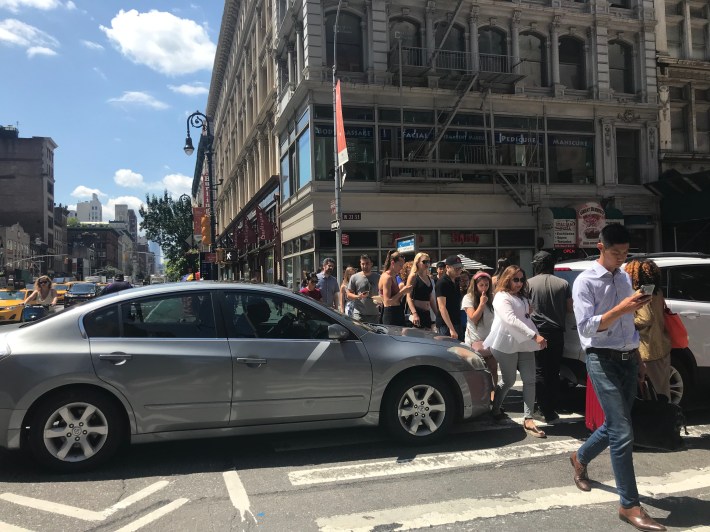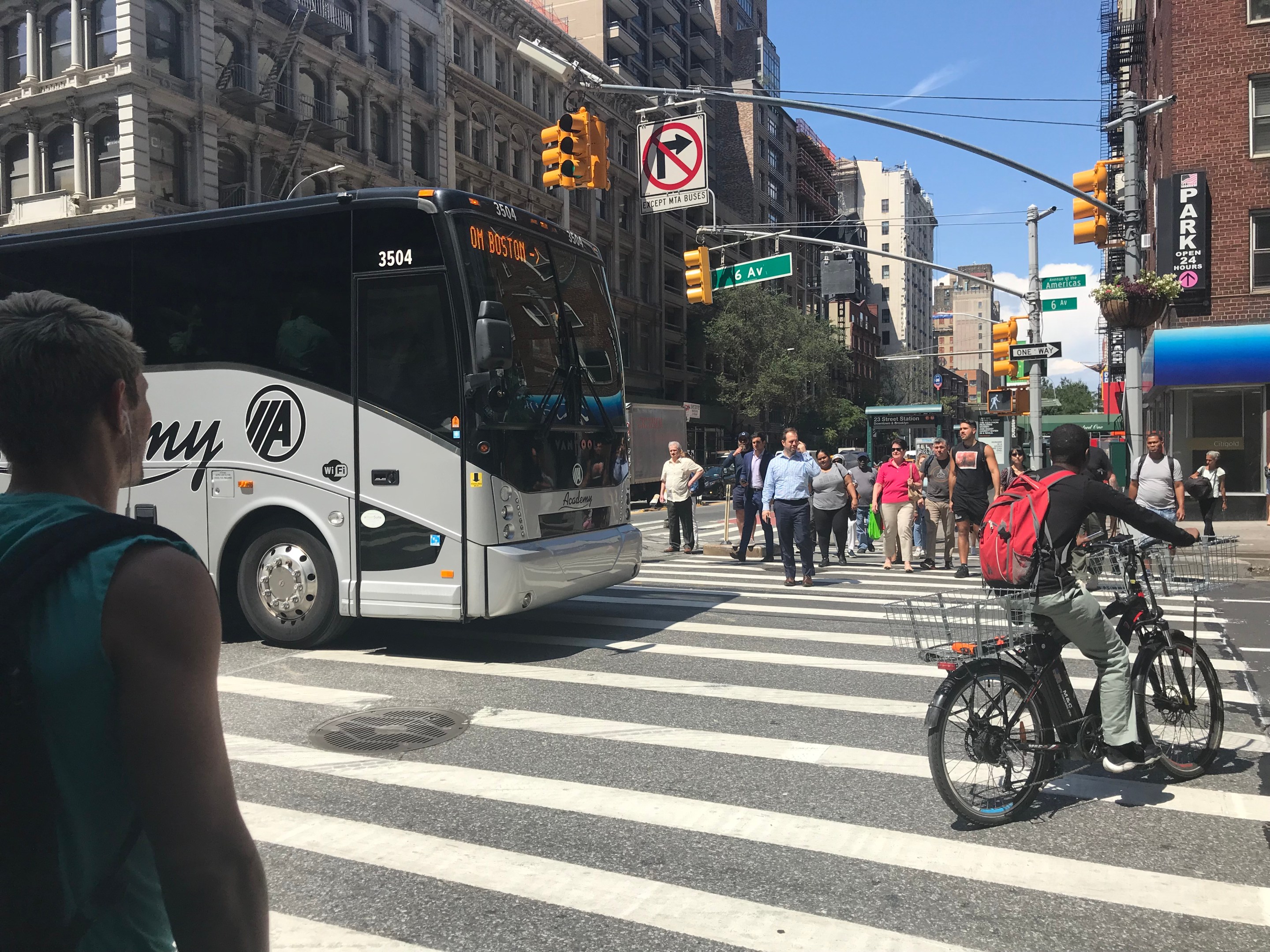City officials are under fire following the death of a pedestrian after an apparent collision with a cyclist in Chelsea last month — but they're being slammed not doing more to protect the most vulnerable road users at many poorly designed intersections in the city where cars are outnumbered yet get the vast majority of the roadway anyway.
Chelsea resident Michael Collopy, 60, is the second person to be killed there in two months — safe-street advocates and local pols warn he won't be the last unless the city immediately does something to make it safer, like nix a lane of traffic, so that pedestrians and cyclists aren't forced to squeeze into narrow pathways, said Council Speaker Corey Johnson, who represents the area where the fatal crash occurred.
“What we need is better infrastructure and safer streets that make everyone safer, especially pedestrians and cyclists,” Johnson tweeted last week. “I want to see plans to improve this intersection immediately."
His comments echo those of Hindy Schachter, who has every reason to be angry at cyclists after one killed her husband in 2014 — yet consistently blames bad road design for the continued violence on New York City streets.
“There are people who will talk about bad cyclists who whizz by them — sure let’s give that cyclist a ticket," she told Streetsblog. "But the issue is not the few cyclist fatalities, the issue is the fatalities as a whole, the vast majority of which come from motor vehicles, and the solution is a totally different way of designing streets.”
The city should listen to her — especially at the chaotic intersection of Sixth Avenue and 23rd Street. Six cyclists, 18 pedestrians and 15 drivers have been injured at the intersection since January, 2016 — and it's no wonder, given that the roadway has four through lanes for cars and two turning bays for drivers looking to go east or west on 23rd Street. That leaves very little room for pedestrians and cyclists.
Collopy’s death comes less than two months after a truck driver hit and killed 20-year-old Robyn Hightman on June 24 — video shows him lying severely injured on the ground just feet from Hightman's ghost bike and makeshift memorial. Since then, several others within the same few blocks have just narrowly missed the same fate. And a woman pedestrian was critically injured last week by a car driver nearby.
This is now at least the fourth, I believe, non-fatal crash near Sixth Avenue and 25th Street since late June, when a truck driver killed 20-year-old Robyn Hightman. https://t.co/0M5vmmAwjo https://t.co/CxX8Wbo7qC
— Julianne Cuba (@Julcuba) July 24, 2019
Streetsblog visited the intersection of 23rd Street and Sixth Avenue on Friday at noon — around the same time Collopy was struck — and observed a sea of pedestrians trying to maneuver past cars and trucks, as some of the drivers inside them inched up into the crosswalk, selfishly forcing pedestrians to walk around and between their 3,000-pound machines.

In the span of one green light, Streetsblog counted about 25 vehicles heading north on Sixth Avenue. At about the same time, we counted roughly the same number of pedestrians crossing at just one of the four corners, and about a dozen cyclists.
One delivery cyclist said the intersection is havoc because it caters more to motorists than to pedestrians and other users of the public space. He criticized the city for creating only a tiny pedestrian island that separates the sidewalk from a row of traffic because the island is too small to accommodate all the users.
“This intersection is all set up wrong. The real problem is the island, it kind of incentives people to walk out and stand in the way,” said Gerardo Valencia. “They should really change it.”
Another pedestrian crossing the intersection said she regularly observes drivers invading her public space as they try to turn into the crosswalk, just as Streetsblog captured on camera.
“What’s really bad is when you're allowed to walk and there's other cars coming when I know it’s my right to cross and see another car just pass by,” said Conceptia Sulfrain.
Police had said that Collopy was struck by the unknown cyclist as he stood in the protected bike lane at Sixth Avenue and 23rd Street on July 31 — but the city medical examiner disputed an NYPD statement that the cyclist definitively caused Collopy’s death on Aug. 5. The investigation is ongoing.
“The ME has not yet made a determination (decided cause/manner of death) in this case,” said a spokeswoman for the medical examiner’s office.
But no matter what the exact events are that led to Collopy's death, more must be done to protect pedestrians and cyclists, who are the most vulnerable people on New York City's streets, said Transportation Alternative's co-deputy director Marco Conner.
New York's streets have been exceptionally bloody this year, with 130 road fatalities through Aug. 8 this year, up at least 20 percent from last year’s 108 over the same time frame. There have been 67 pedestrian deaths, up 15.5 percent from the 58 that had been killed by this point last year, and 18 cyclist deaths so far this year, up from eight by this point last year, an increase of 125 percent.
“All New Yorkers deserve safe streets and the ability to navigate our city without fear of injury and death. Every person killed on New York’s streets is one too many, regardless of the type of vehicle by which they’re struck. Michael Collopy’s death is a tragedy and could have been prevented," said Connor.
The Department of Transportation says it will review the intersection for “potential improvements” as it does at every location where a fatal crash occurs, but did not comment on whether it would eliminate at least one of the lanes of traffic on Sixth Avenue to make room for more pedestrian and bike infrastructure.
Neither Mayor de Blasio's so-called "Green Wave" bike-safety program nor his pedestrian-safety plan unveiled earlier this year includes any car-reduction strategies. In fact, under this mayor, driving by city employees has risen dramatically and the size of the city fleet has also grown by double-digits.






